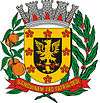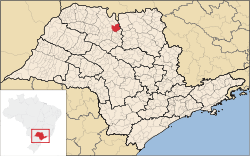Olímpia
Olímpia is a municipality in the northern part of the state of São Paulo, Brazil. The population, measured in 2010 by the IBGE, is 50,024 inhabitants.[1] The city has an area of 802.6 km2 (309.9 sq mi).
Olímpia | |
|---|---|
| The Municipality of Olímpia | |
 Flag  Seal | |
| Nickname(s): Folklore's National Capital, The Lady Girl City | |
 Location of Olímpia | |
| Coordinates: 20°44′14″S 48°54′53″W | |
| Country | |
| Region | Southeast |
| State | |
| Mesoregion | São José do Rio Preto |
| Government | |
| • Mayor | Eugênio José Zuliani |
| Area | |
| • Total | 802.6 km2 (309.9 sq mi) |
| Elevation | 506 m (1,660 ft) |
| Population (2010/IBGE) | |
| • Total | 50,024 |
| • Density | 62.32/km2 (161.4/sq mi) |
| Time zone | UTC-3 (UTC-3) |
| • Summer (DST) | UTC-2 (UTC-2) |
| Postal Code | 15400-000 |
| Area code(s) | +55 17 |
| Website | Olímpia's Prefecture |
Olímpia is not named after the ancient town in Greece (see Olympia, Greece), but from Maria Olímpia Rodrigues Vieira, daughter of the politician Dr. Antônio Olímpio Rodrigues Vieira, one of those responsible for the founding of the city.
The city belongs to the Microregion of São José do Rio Preto.
History
The mineiro Antônio Joaquim dos Santos established a farm on the region in the 19th century. He named the farm, "Sertão dos Olhos-d'Água" (Eyes of Water Backwoods). The engineer Robert John Reid arrived, to demarcate lands of the farm. In March 1903, parts of the farm gave birth to the village of "São João Batista dos Olhos d'Água".
On December 18, 1906, the town was elevated to district of Barretos, receiving the name of "Vila Olímpia", after Maria Olímpia Rodrigues Vieira, daughter of the politician Dr. Antônio Olímpio Rodrigues Vieira, one of those responsible for the city creation.
In 1907 the first cinema theater was built in Vila Olímpia, the Cine São João, by Miguel Haidar and Guilherme Costa. In 1910, Cap. Narciso Bertolino founded the first school in town. A cemetery named São José was first opened in 1914.
The municipality of Olímpia was established in December 7, 1917, with the emancipation from Barretos.[2]
Economy
The economy of the city has the Tertiary sector as basis. 65.5% of Olímpia's GDP comes from the Commerce and Services, 26% from Industry and 8.2% from the Primary sector.[3]
Culture
Olímpia is known as Brazil's Folklore Capital, due to the "Festival Nacional do Folclore", an annual festival, and the Museum of Folklore. The city has a park of thermal waters, the "Parque Aquático Thermas dos Laranjais".[4]
Transportation
External links
- (in Portuguese) Official Site of Olímpia's Prefecture
- (in Portuguese) citybrazil.com.br
References
- "2010 Census of the IBGE - Population - Table 2.1.20" (PDF). IBGE.gov.br. Retrieved 15 July 2011.
- "History of the City" (in Portuguese). Olimpia.sp.gov.br. Retrieved 9 July 2011.
- "Municipal Profile at SEADE" (in Portuguese). Fundação SEADE. Archived from the original on 23 August 2011. Retrieved 8 July 2011.
- ""The City" on Olímpia's Prefecture Site" (in Portuguese). Olimpia.sp.gov.br. Retrieved 9 July 2011.
